
[Source: Nick Catford & Darren Kitson]
Saffron Walden Station Gallery 1 April 1917 - April 1929 walden_old2.jpg) Looking south-west towards Saffron Walden station before April 1917. A locomotive is seen running round its coaches. A number of wagons are seen in foundry siding on the left.
Copyright photo from John Alsop collection 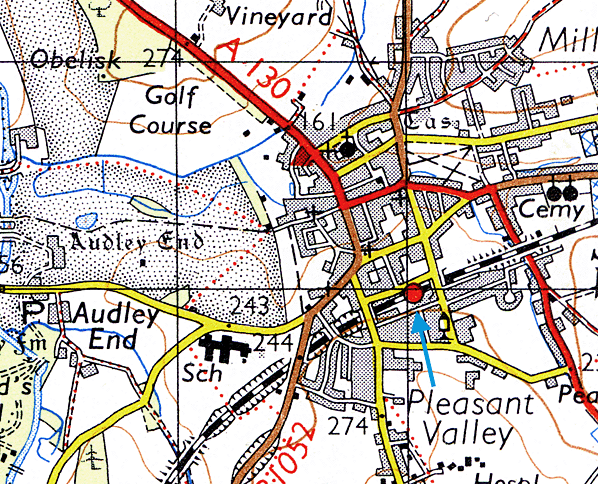 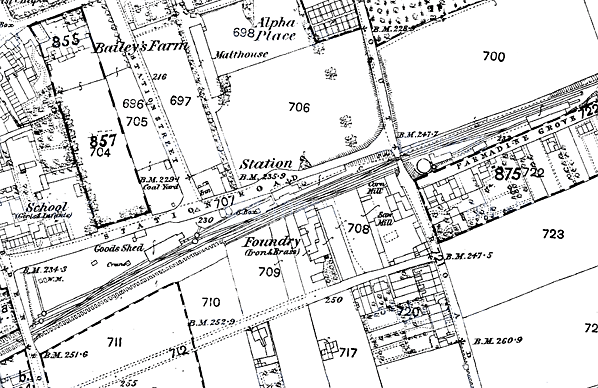 1887 1:2,500 OS map shows the extensive area covered by the station, goods yard and engine shed. Debden Road is seen bottom left with South Road crossing the line right of centre. The goods yard starts immediately east of Debden Road and the engine shed is east of South Road. A crane is identified to the west of the goods shed; this does not appear on later maps and photographic evidence shows the crane has been moved to the east end of the goods dock to the south of the line.
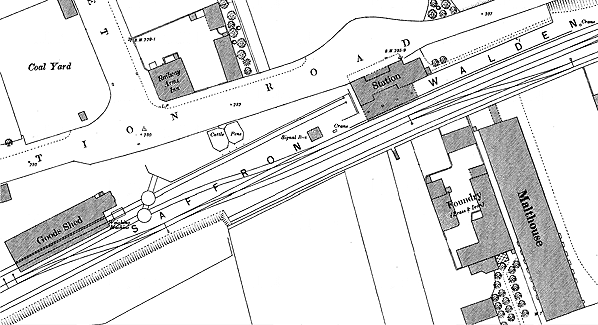 1878 1:500 OS Town Plan shows the layout of the station and east end of the goods yard. The single platform and canopy is seen in front of the station building with the signal box at the west end of the platform. Water cranes are shown at both ends of the platform; that at the west end was removed at an early date. The foundry siding is seen opposite the station building, with the foundry to the west of the malthouse. The cattle dock and siding are seen to the west of the station with livestock pens on the dock. The goods shed is seen bottom left with the track crossing over a weigh bridge to the east of the shed. Note the two wagon turntables east of the shed to allow single wagons to be turned
end-on to the cattle dock. 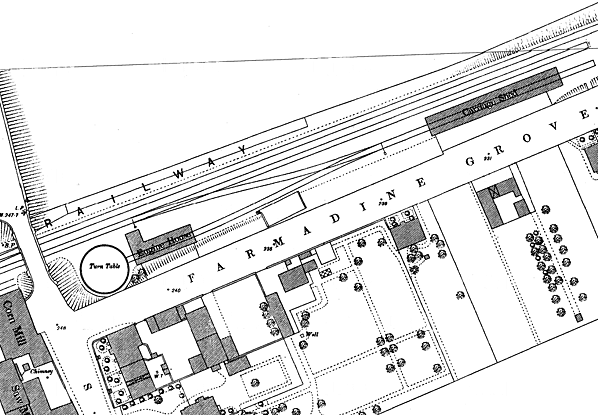 1878 1:500 OS Town Plan shows the engine shed with a 40ft turntable to the rear. A coal stage is seen alongside the shed road. To the right there is a single-road carriage shed; this proved surplus to requirements and was closed and demolished at an early date
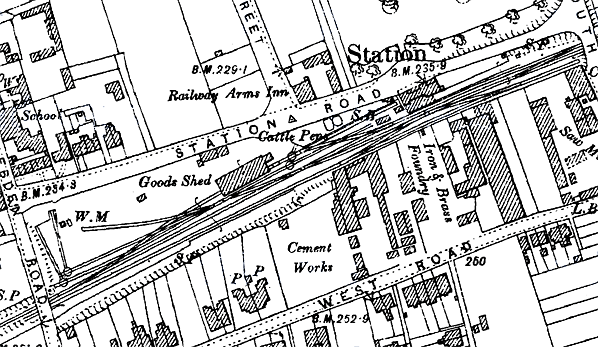 1897 1:2,500 OS map shows little has changed apart from an additional siding running diagonally across the yard to the west of the goods shed, this served the coal yard to the north of the siding. At a later date a second parallel siding was added. There has been some residential development to the south of the line.
walden_old21.jpg) Looking north-east at Saffron Walden goods yard and station from Debden Road bridge. The ‘Railway Arms’ public house is seen below the tree line top left. The South Road bridge is seen in the distance beyond the station. The running line is the unoccupied road on the right. Empty wagons stand in Dixie's siding on the far right with the goods dock visible in the distance. The main goods yard is on the left with the coal yard just visible on the far left towards the top. One of four wagon turntables is seen bottom left with a short siding at right angles out of view to the left. The yard had a total capacity of 112 wagons; 50 are seen in this view from 1911. A number of private owner wagons are visible, while those on the right mainly belong to the GER. The wagon near left is being unloaded and a horse and cart is present. In the days before road motor transport, this could be a time consuming and
laborious process. Photo from John Mann collection walden_old22.jpg) The Great Eastern single-road engine shed is seen from an unknown elevated position in 1911. South Road bridge and corn mill are seen in the distance. The water tank to the right of the shed fed two water cranes; one is seen here, the other was at the east end of the passenger platform. The 40ft turntable is just visible behind the shed with an inspection pit in front of the shed and a
coaling stage bottom left. Photo from John Mann collection walden_old19.jpg) Aerial view of Saffron Walden station in April 1929. The 32-lever signal box is seen at the east end of the platform. The siding running behind the signal box served the cattle dock which is seen on the left complete with livestock pens. The angled section in the left was originally an end dock with a single wagon siding accessed from a wagon turntable end on to it. (see Town Plan above). A cattle market was established in the town in 1834. Dixie's siding is seen bottom left with a number of box wagons standing in the dock. The foundry siding is opposite the station building. Reproduced with the kind permission of Simmons Aerofilms Ltd walden_old20.jpg) Another section of the 1929 aerial photograph showing the goods shed and goods office in the centre; the coal yard is seen on the left. The second goods dock, alongside Dixie's siding, is seen at the bottom. The ‘Railway Arms’ public house is seen top right at the junction of Station Road and Station Street; it is the only building in this view and the view above that is extant. What was once an industrial area is now entirely residential. Reproduced with the kind permission of Simmons Aerofilms Ltd.
Click here for Saffron Walden Station Gallery 2
 Home
Page Home
Page
|

 There was a single 202ft platform on the down side of the line. There was a white brick, unusually large two-storey, 'H' shaped building with a pitched slate roof. The building was bigger than usually provided for a town the size of Saffron Walden and included the booking office, general and ladies' waiting rooms and toilets. The stationmaster had his office in a separate external building between the main building and the signal box. The upper floor of the main building was accommodation for the stationmaster. There was a small canopy over the station entrance for the benefit of arriving passengers in bad weather. On the platform side there was a slightly upward sloping canopy supported on cast iron columns stretching the full width of the platform. The station was initially gas-lit but electric lighting was installed by the LNER.
There was a single 202ft platform on the down side of the line. There was a white brick, unusually large two-storey, 'H' shaped building with a pitched slate roof. The building was bigger than usually provided for a town the size of Saffron Walden and included the booking office, general and ladies' waiting rooms and toilets. The stationmaster had his office in a separate external building between the main building and the signal box. The upper floor of the main building was accommodation for the stationmaster. There was a small canopy over the station entrance for the benefit of arriving passengers in bad weather. On the platform side there was a slightly upward sloping canopy supported on cast iron columns stretching the full width of the platform. The station was initially gas-lit but electric lighting was installed by the LNER.
 The goods yard was to the west of the station; it had facilities on both sides of the line. On the up side the 637ft-long Dixie's siding which had a loading dock with a 1 ton 10 cwt capacity crane at the east end. Road entrance to the dock was from Debden Road. The down side goods yard had a loop siding reached from both directions which passed thorough a large brick goods shed with a second 1 ton 10cwt capacity crane. Cattle pens and a dock were sited between the shed and the station. There were coal bins to the west of the shed and two short sidings at right angles with wagon turntables for access. Road access was from Station Road where there was a weighbridge.
The goods yard was to the west of the station; it had facilities on both sides of the line. On the up side the 637ft-long Dixie's siding which had a loading dock with a 1 ton 10 cwt capacity crane at the east end. Road entrance to the dock was from Debden Road. The down side goods yard had a loop siding reached from both directions which passed thorough a large brick goods shed with a second 1 ton 10cwt capacity crane. Cattle pens and a dock were sited between the shed and the station. There were coal bins to the west of the shed and two short sidings at right angles with wagon turntables for access. Road access was from Station Road where there was a weighbridge.
 It was soon apparent to the town council that they needed a railway connection to arrest the economic depression which had descended on the town. A public meeting was held in 1860, and a proposal was put to the Eastern Counties Railway for a branch from Audley End to Saffron Walden. Sufficient local finance was soon forthcoming, and a Bill was put before Parliament on 14 November 1860 with the Saffron Walden Railway Act receiving Royal Assent on 22 July 1861.
It was soon apparent to the town council that they needed a railway connection to arrest the economic depression which had descended on the town. A public meeting was held in 1860, and a proposal was put to the Eastern Counties Railway for a branch from Audley End to Saffron Walden. Sufficient local finance was soon forthcoming, and a Bill was put before Parliament on 14 November 1860 with the Saffron Walden Railway Act receiving Royal Assent on 22 July 1861.  Construction of the Saffron Walden branch started on 18 May 1863, and on 2 June 1863 the Saffron Walden Railway Extension Act received Royal Assent. The construction of the line was virtually trouble-free and, after passing a Board of Trade inspection on 18 November 1865, the branch to Saffron Walden opened five days later. The extension to Bartlow, although running through a much hillier terrain requiring cuttings and embankments, was completed 11 months later opening on 26 October 1866.
Construction of the Saffron Walden branch started on 18 May 1863, and on 2 June 1863 the Saffron Walden Railway Extension Act received Royal Assent. The construction of the line was virtually trouble-free and, after passing a Board of Trade inspection on 18 November 1865, the branch to Saffron Walden opened five days later. The extension to Bartlow, although running through a much hillier terrain requiring cuttings and embankments, was completed 11 months later opening on 26 October 1866.
 WW1 brought added prosperity; although the line was now under government control, the pre-war passenger timetable was retained, and goods traffic flourished as home grown produce was dispatched to towns and cities to make up for the loss of imported food. The countryside around Saffron Walden was also used for troop training which brought added traffic to the branch.
WW1 brought added prosperity; although the line was now under government control, the pre-war passenger timetable was retained, and goods traffic flourished as home grown produce was dispatched to towns and cities to make up for the loss of imported food. The countryside around Saffron Walden was also used for troop training which brought added traffic to the branch. After the war the service began to deteriorate with freight traffic in decline once again following the lifting of petrol rationing. By the early 1950s the increase in car ownership led to a dramatic loss in passenger revenue, but as several of the surrounding lines closed the Saffron Walden branch survived and, as part of the 1955 BR Modernisation Plan, diesel railbuses were introduced on 7 July 1958. Despite their success the line was listed for closure in the 1963 ‘Beeching Report’; and despite a spirited local attempt to keep the line open the passenger service was withdrawn from 7 September 1964. Within a month of closure, BR announced their intention to withdraw freight facilities from 28 December 1964.
After the war the service began to deteriorate with freight traffic in decline once again following the lifting of petrol rationing. By the early 1950s the increase in car ownership led to a dramatic loss in passenger revenue, but as several of the surrounding lines closed the Saffron Walden branch survived and, as part of the 1955 BR Modernisation Plan, diesel railbuses were introduced on 7 July 1958. Despite their success the line was listed for closure in the 1963 ‘Beeching Report’; and despite a spirited local attempt to keep the line open the passenger service was withdrawn from 7 September 1964. Within a month of closure, BR announced their intention to withdraw freight facilities from 28 December 1964.

